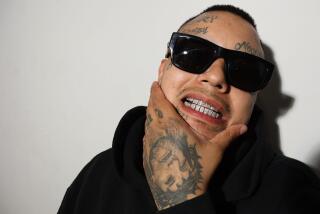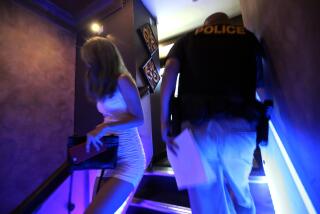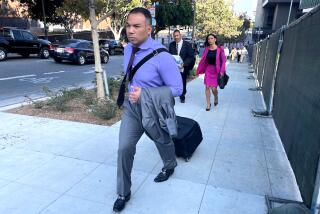Trial opens for alleged ‘all-star team’ of Chicago gangsters
The Hobos gang came calling for Keith Daniels on an April evening three years ago.
Daniels, a key witness in a drug trafficking case against the gang’s feared leader, had been relocated by authorities to the southern Chicago suburb of Dolton for his safety. But when the 27-year-old father pulled into his driveway with his wife and her two young kids, a gunman walked up and opened fire through the windshield, according to court records.
Daniels bailed out of the car and tried to run but was quickly cut down by more than two dozen bullets as the children, ages 6 and 4, screamed in the backseat. After the assailant jumped into a waiting SUV and sped off, Daniels’ wife called 911 to report her husband had just been shot.
“I know who it was,” she said, repeating the name three times: “Poleroski. Poleroski. Poleroski.”
Federal prosecutors say Poleroski was the street name for Paris Poe, a Hobos lieutenant who had cut off a court-ordered electronic monitoring device from his ankle and killed Daniels to keep him from testifying against Poe’s boss, Gregory Chester.
On Wednesday, Poe, Chester and four other alleged leaders of the Hobos went on trial on sweeping racketeering conspiracy charges alleging the gang was responsible for nine killings — including Daniels’ 2013 slaying — as well as a slew of shootings, robberies and home invasions. Each of the six faces up to life in prison if convicted.
During his 90-minute opening statement, Assistant U.S. Atty. Patrick Otlewski held up assault rifles and other weaponry he said the gang used to reign supreme in the South Side drug trade.
“This case is not about a group of misguided youth, of teens hanging out on a street corner. Not for one minute,” Otlewski said. “You will see what happens when the worst of the worst of Chicago gangs gets together. … This was an all-star team.”
In addition to the frantic 911 call from Daniels’ wife, jurors could hear dramatic testimony from both of his stepchildren about what they saw the day he was killed. In an interview with authorities in 2013, the younger child said the “Boogie Man” who shot Daniels was wearing a Spider-Man mask. That appears to conflict with the mother’s account that she saw Poe’s face, a recent court filing shows. The older child also said the killer was wearing a mask.
Prosecutors, meanwhile, have objected to the defense calling the children to the witness stand, saying they are not competent to testify under federal trial rules because of their ages.
Not since the El Rukn trials two decades ago has so much violence been alleged against a single Chicago gang. Heavy security has been put in place at the Dirksen U.S. Courthouse in downtown Chicago for the trial, which is expected to last three months or more.
You will see what happens when the worst of the worst of Chicago gangs gets together. … This was an all-star team.
— Assistant U.S. Atty. Patrick Otlewski
A metal detector was set up outside U.S. District Judge John Tharp’s 14th-floor courtroom, where lawyers and the judge spent five days interviewing potential jurors who were identified only by number.
The U.S. Marshals Service had warned of threats made against witnesses and asked that the defendants’ legs remain shackled during the trial. Tharp ruled against it because of the “very real” possibility it would prejudice jurors.
However, the courtroom was set up with long tables draped with black skirting that blocks views of the legs of those seated. That way, the judge said, if he has to order shackles at some point during the trial, the jury will not notice any difference.
The trial comes at a time of increased concern about violence in Chicago with homicides and shootings soaring by close to 50% over a year earlier, to levels unseen in two decades. Gangs drive much of the violence.
Prosecutors allege the Hobos represented a new breed of gang made up of members from diverse gangs who were once rivals. Many of the Hobos started in the now-demolished Robert Taylor and Ida B. Wells public housing complexes from factions of the Gangster Disciples and the Black Disciples street gangs, according to prosecutors.
The origin of the Hobos’ name is uncertain — possibly a reference to the loss of their homes after the razing of the housing complexes. But jurors are expected to hear evidence that members called each other Hobo during conversations, got tattoos identifying themselves as Hobos, used a unique hand sign and took lavish trips together to Mexico and the Caribbean.
The gang violently rose to the top of the city’s drug trade, prosecutors allege. While the gang’s criminal activity dates to at least 2004, the killings alleged in the indictment took place from 2006 to 2013. Among the casualties were two gang rivals who had just attended a funeral, a semipro basketball player who was slain in a case of mistaken identity, and an innocent bystander from Los Angeles, Kevin Thompson, who was visiting relatives.
The gang allegedly enhanced its street reputation by carrying out robberies and home invasions of drug dealers and other well-to-do targets, including Bobby Simmons, a former NBA player whose white gold necklace worth more than $200,000 was stolen from him at gunpoint in June 2006 outside a nightclub.
But the focus of the trial will be the killings.
“For nearly a decade, the Hobos’ ruthlessness and violence struck fear in the hearts of people living on the South Side of Chicago,” Otlewski told jurors. “They arrogantly believed that they were above the law.”
Meisner reports for the Chicago Tribune.
ALSO
The $3.7-billion pipeline that became a rallying cry for tribes across America
Technician who deleted Clinton emails declines to answer questions from Congress
Median incomes are up and poverty rate is down, surprisingly strong census figures show
More to Read
Start your day right
Sign up for Essential California for news, features and recommendations from the L.A. Times and beyond in your inbox six days a week.
You may occasionally receive promotional content from the Los Angeles Times.






